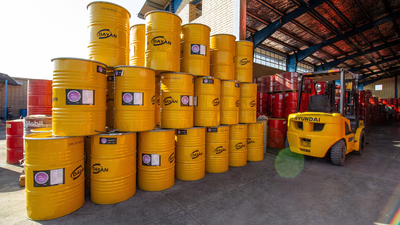
Base oil production has evolved significantly over centuries.
The use of lubricants can be traced back to ancient civilizations. Early civilizations, such as the Sumerians and Egyptians, used various substances like animal fats and vegetable oils to reduce friction and provide lubrication for their machinery and chariots. The modern history of base oils began with the development of the petroleum industry in the 19th century. The discovery of large oil reserves and advancements in drilling and refining techniques led to the commercial production of petroleum products. The field of base oils continues to evolve with ongoing research and innovation. Efforts are being made to develop base oils with improved environmental sustainability, higher performance levels, and better compatibility with modern engine technologies.
Base oil production technology has gone through several phases of evolution. In the first phase, animal fats were used as lubricants. Inscriptions dating to 1400 BC inform of the use of hard fat of pigs and sheep (called pi) to lubricate the wheels of carriages.
During the next 3,000 years, there was little change in this area, and it can be said that only at certain points, the desired oils were obtained from animals such as whales.
In 1852, crude oil-based oils were introduced. Such oils were not considered at first because they did not perform better than animal-based oils. Therefore, it can be said that crude oil did not produce a good lubricant and in general, the base oil industry was not in a good situation due to lack of knowledge. But as demand for automobiles grew, so did the demand for better lubricants, and it was not long before lubricant manufacturers realized which type of crude oil produced the best lubricants. Then They produced better lubricants by converting crude oil into cuts with lower distillation amplitudes and different viscosities.
Prior to 1920, engine oils were free of additives, and after 1,300 to 1,600 km, vehicle oils were changed. Therefore, in 1923, the Society of Automotive Engineers (SAE) classified engine lubricants as light, medium, and heavy in terms of viscosity. However, due to the needs of the day, more and more lubricant manufacturers began to refine base oils in order to improve their efficiency.
In the early days, the primary focus of refining crude oil was to produce kerosene for lighting. However, as the demand for lubricants grew with the rise of industrialization, refining techniques were developed to extract lubricating oils from crude oil. As the demand for lubricants increased, the need for consistent quality and performance became apparent. This led to the establishment of various base oil grades to classify oils based on their refining methods, composition, and performance characteristics. The American Petroleum Institute (API) introduced its base oil classification system, which categorized base oils into different groups based on their refining processes and properties.
Over time, advancements in refining technology and processes allowed for the production of higher-quality base oils. Techniques such as solvent extraction, hydroprocessing, and catalytic dewaxing were developed to remove impurities, improve viscosity control, and enhance the performance characteristics of base oils. In the mid-20th century, the development of synthetic base oils marked a significant advancement in lubricant technology. Synthetic base oils, such as polyalphaolefins (PAOs) and esters, offered superior performance properties compared to mineral-based oils. These synthetic base oils found applications in high-performance lubricants, including those used in aerospace, automotive, and industrial sectors.
-

Base oil is primarily consumed by the lubricant industry, which includes automotive, industrial, marine, and aviation sectors. Its demand is closely linked to lubricant consumption, driven by factors such as industrial growth, vehicle sales, and machinery maintenance. The automotive sector significantly influences base oil demand due to the number of vehicles on the road and their maintenance needs. Industrial activities like manufacturing and construction also rely heavily on lubricants derived from base oil. Base oil is produced through refining crude oil or chemical synthesis and serves as a key raw material for engine oils and industrial lubricants. The production process involves heating crude oil to separate lighter hydrocarbons for fuels while heavier ones are refined into base oils. Additives are incorporated to enhance properties like friction resistance and cleaning capabilities. Market trends indicate a growing shift towards high-performance and environmentally friendly lubricants, affecting specific base oil grades" demand.
Regional variations in industrial activity and economic development influence base oil consumption patterns, with emerging economies experiencing increased demand due to rapid urbanization. Additionally, recycling processes for used lubricants are gaining traction, providing sustainable alternatives that may impact virgin base oil demand. "
-

Base oil is a crucial component in the formulation of lubricants, primarily derived from refined petroleum. It constitutes over 95% of most lubricants, including motor oils and hydraulic fluids. The refining process yields base oils with desirable properties such as high viscosity index, thermal stability, and oxidation resistance, which are essential for reducing friction and protecting machinery. Base oils can be categorized into five groups by the American Petroleum Institute (API), ranging from less refined to specialty oils. While most base oils are petroleum-based, synthetic alternatives like polyalphaolefins and esters are gaining popularity due to their superior performance in extreme conditions. The increasing reliance on base oil in lubricant efficiency highlights its significance in the industry.
-

West Asia, particularly the Middle East, is a crucial hub for base oil production due to its vast crude oil reserves and advanced refining infrastructure. Saudi Arabia leads the region with its extensive refining capabilities, primarily through Saudi Aramco, which produces various grades of base oils. The UAE follows closely, with significant contributions from ADNOC and ENOC, focusing on high-quality base oils. Iran also plays a vital role in this sector, leveraging its historical oil production and refining expertise through the National Iranian Oil Company (NIOC). Other countries like Kuwait, Qatar, and Oman are also notable producers, each with their own state-owned entities managing oil production and refining. The region"s strategic location and investments in modern refining technologies ensure a steady supply of base oils to meet both regional and global demands. Base oils produced in West Asia adhere to international certifications such as ISO 9001 and ISO 14001, ensuring quality standards are met. The complexity of producing engine oils involves not just base oils but also various additives that enhance lubrication properties.
As the industry evolves, new standards are being developed to optimize fuel efficiency and reduce engine wear. "
-

Base oils have a rich history dating back to ancient civilizations, where lubricants were derived from animal fats and vegetable oils. The modern era of base oils began in the 19th century with the rise of the petroleum industry, driven by significant oil discoveries and advancements in refining techniques. Initially, crude oil-based lubricants were not favored due to their inferior performance compared to animal-based options. However, as automobile demand surged, manufacturers began optimizing crude oil processing to produce better lubricants. By the early 20th century, engine oils were classified by viscosity, leading to a focus on refining for improved efficiency. The American Petroleum Institute established a classification system for base oils based on refining methods and properties. Over time, innovations such as solvent extraction and hydroprocessing enhanced base oil quality. The introduction of synthetic base oils in the mid-20th century marked a pivotal shift in lubricant technology, offering superior performance for various applications including automotive and industrial uses. Today, ongoing research aims to develop environmentally sustainable base oils that meet modern engine requirements.




